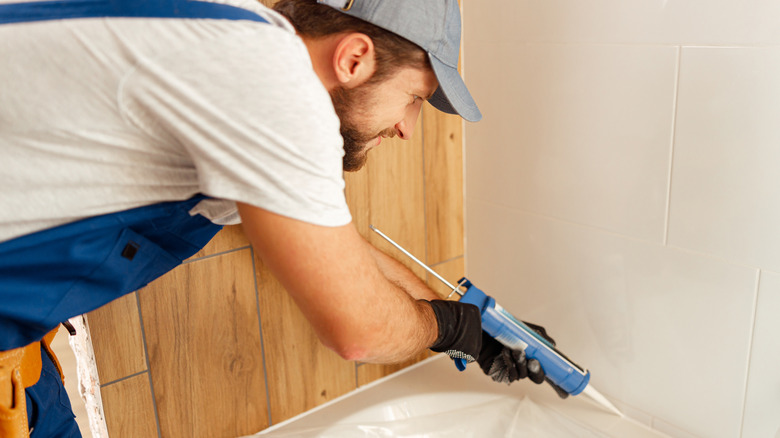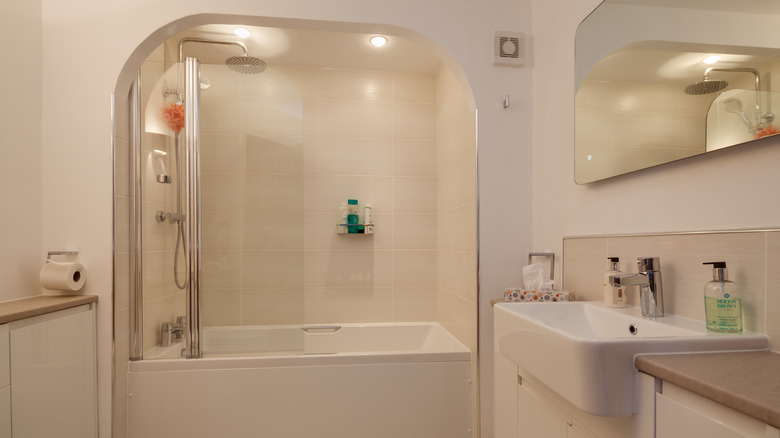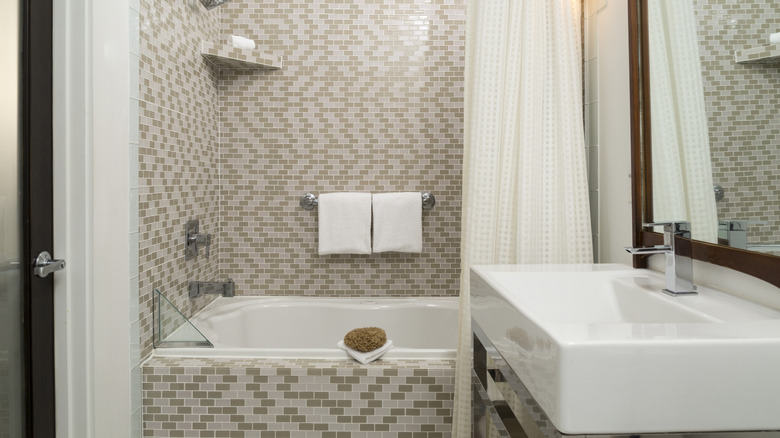It's No Trend — This Bathroom Upgrade Remains A Timeless, Classic Design
We may receive a commission on purchases made from links.
Upgrading a bathtub is a big swing to take. You may feel a very sensible trepidation about whether you'll love the tub setup just as much years down the road once the novelty fades. Certain upgrades, though, are regret-proof because they rest on timeless design principles and are endlessly useful. Enclosing your bathtub in an apron or panel for an alcove look is one of them.
Alcove bathrooms are plentiful for a reason. They're nestled in between three walls, creating coziness. When you add panels, the tub appears even more solidly built into the bathroom, offering a sense of permanence. This kind of tub is a good fit for many homes, and with a standard size of around 5 feet, it helps make good use of space in small bathrooms. This is especially true because many alcove tubs combine the shower and bath.
Just because alcove baths are timeless doesn't mean they are everyone's cup of tea, though. If you're looking for more flexibility in terms of where to place the tub, as well as its shape and dimensions, a drop-in or freestanding tub may be more suited to your style. When you put in a drop-in bathtub, you don't have to place it between three walls as you would with an alcove type. If you like the increased depth of a drop-in tub but the appearance of an alcove, you can actually combine the two by placing the drop-in tub between three walls and finishing the front of it within the same color tile as the walls. When the goal is to go for a more dramatic look, you could plan a renovation that will let you relax in a freestanding bathtub; you can show off its shape and materials since all its sides are exposed.
Benefits of upgrading to an alcove bathtub
You'll know that an alcove bathtub is right for your bathroom if you enjoy its nested vibe, but also if you're looking to save money on the upgrade. At an average of between $1,625 and $2,000, installing an alcove tub typically costs less than upgrading to a drop-in or freestanding tub, as long as the plumbing situation is uncomplicated. The two sides of the tub attached to the wall in an alcove bathtub are unfinished, so you can focus the project budget more on the visible side facing the room and customize it to your chosen aesthetic.
Because of the way they're attached, alcove bathtubs can act as a canvas for various design choices. One idea is to cover both the front panel of the alcove and the wall behind it in the same color tile. Subway tiles are popular for this, and you can go with a bold color tile or try classic subway tile patterns that will fit any space. An ambitious DIYer or professional can add a panel to the side of the tub that faces out into the room, which is a good opportunity to match it to other design elements of the wall or room and create that tucked-in feeling that's hard to tire of. These panels, sometimes called aprons or tub skirts, add detail and a sense of completion to an everyday bathroom staple.
What to keep in mind when you upgrade to an alcove tub
As the upgrade gets underway, it never hurts to soak up a little know-how to make the process easier, prevent future headaches, and learn what other bathroom design features will complement your new tub. When installing the alcove bathtub, it will be crucial to seal the edges properly and use a high-quality grout between the tub and the wall to prevent leaks and unsightly damage. And if you're planning on adding a panel or skirt to the tub, there are models of bathtubs that have a surface attached to one of the sides where tile can be added. Others have a panel you can buy along with the tub, like the Voltaire 60" X 32" Right-Hand Drain Alcove Bathtub with Apron.
Make the most of your refreshed bathroom by pairing the tub with new features that keep it tidy, like built-in shelves or on the wall or ledges on the side of the tub where you can rest soap and shampoo bottles. For a spa-like bath experience, many modern alcove tubs come with air jets — it's even possible to add heated backrests. There are also simpler changes you can make to create a relaxing ambience to go along with your classic tub, like swapping out the bulbs for softer lighting or installing lights that have a dimmer.


